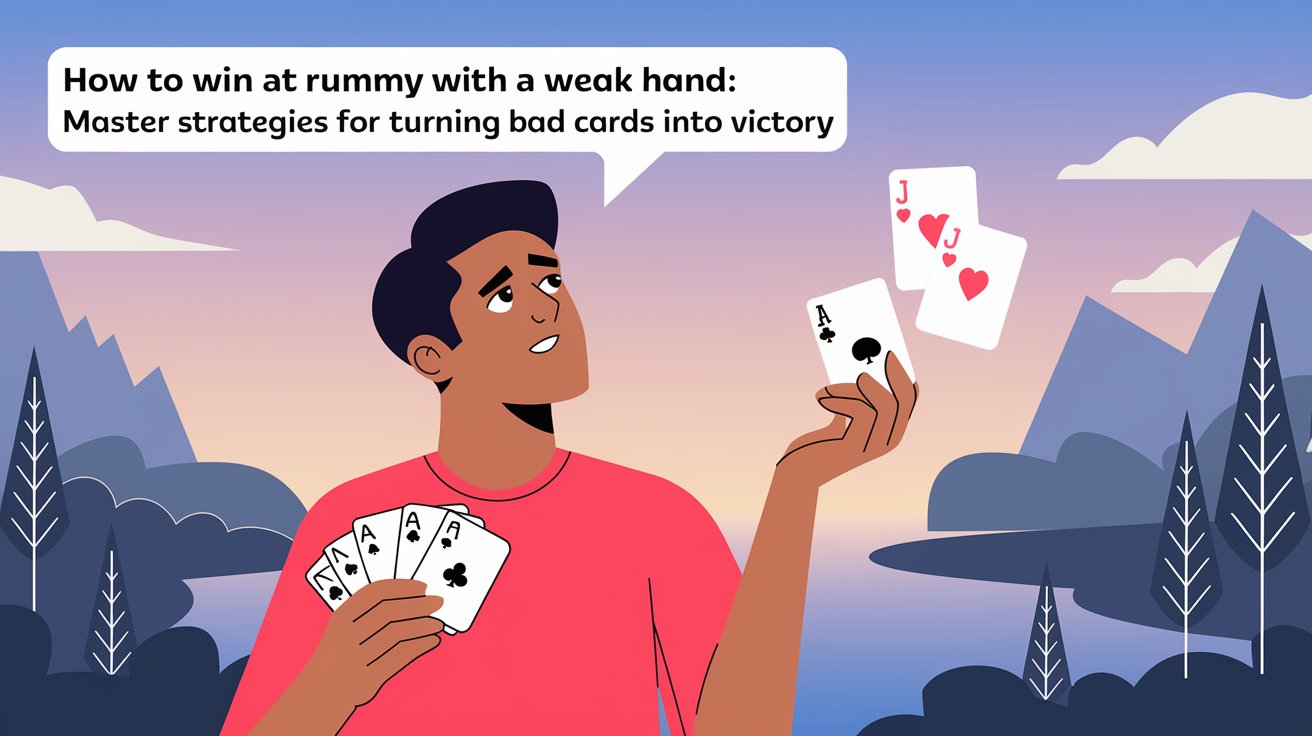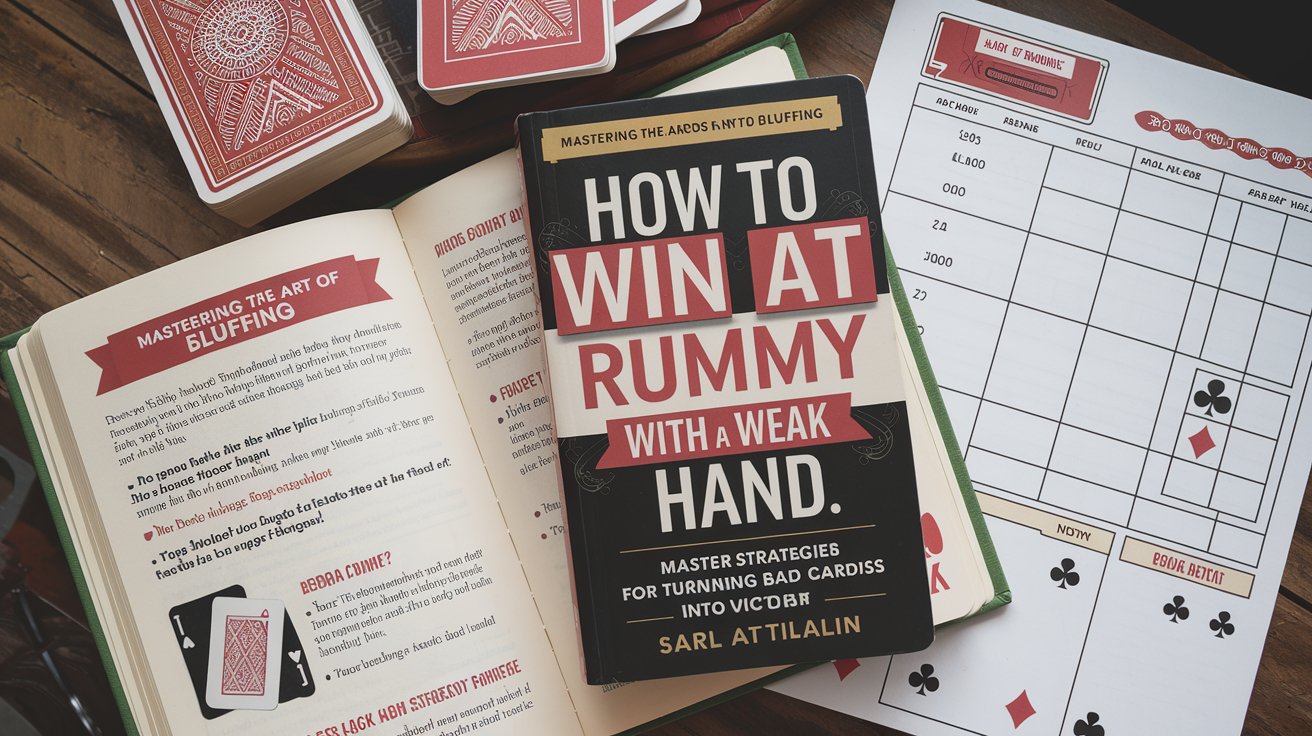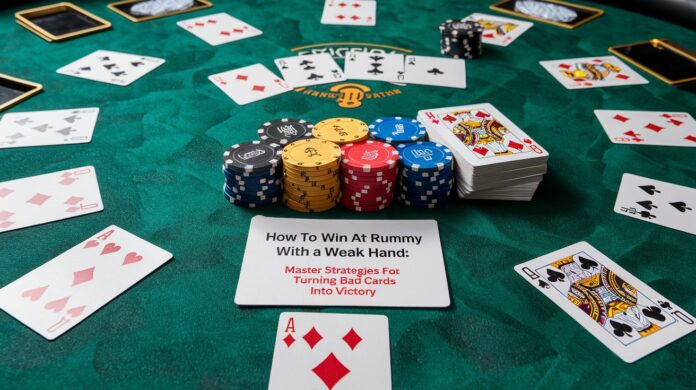Every Rummy player has experienced that sinking feeling when looking at their initial hand: disconnected cards, high-value deadwood, no natural pairs or sequences, and seemingly no path to victory. While a strong starting hand certainly improves your odds, experienced Rummy players know that weak hands don’t automatically mean defeat. In fact, some of the most satisfying wins come from skillfully navigating initially unpromising cards.
In this comprehensive guide, we’ll explore proven strategies, tactical approaches, and psychological techniques that can help you turn a weak Rummy hand into a surprising victory. Whether you’re playing classic Gin Rummy, Indian Rummy, or Rummy 500, these principles will help you stay competitive even when the cards seem stacked against you.
Recognizing a Weak Hand: The First Step to Overcoming It

Before discussing strategies, it’s important to accurately identify a weak hand. Not all challenging hands are created equal, and proper assessment is crucial for developing the right approach.
Characteristics of a Weak Rummy Hand
A weak hand typically includes several of these elements:
- Disconnected Cards: Cards with no natural sequences or adjacency (like 3♥, 7♦, J♠, K♣)
- High Deadwood Value: Many face cards and tens that carry high penalty points
- Suit Dispersion: Cards scattered across all four suits with no concentration
- Few Pairs or Potential Sets: No natural pairs or triplets
- Large Value Gaps: Cards like 2♠, 9♠ (missing connecting cards 3-8)
- Blocked Sequences: Holding 5♦, 6♦, when multiple 4♦ and 7♦ have already been discarded
The Weak Hand Severity Scale
For strategic purposes, categorize your weak hand on this scale:
- Challenging (Some potential): A few connected cards but mostly disconnected
- Difficult (Limited potential): Perhaps one pair or potential sequence among otherwise disconnected cards
- Severe (Minimal potential): Almost entirely disconnected with high deadwood value
Your position on this scale will determine which strategies are most appropriate.
Core Strategies for Weak Hand Management

When faced with a weak hand, these fundamental strategies provide the foundation for a potential comeback:
1. The Focused Abandonment Strategy
Rather than trying to improve your entire hand, identify your strongest potential combination and focus exclusively on it:
Example: With 2♠, 3♠, 9♥, 9♣, K♦, Q♠, J♥, 10♦, 7♥, 8♦, you have two potential focal points:
- The partial spade sequence (2♠, 3♠)
- The partial nine set (9♥, 9♣)
In this case, strategically abandon everything else and focus entirely on completing either the spade sequence or the nine set, whichever seems more promising based on discards observed.
2. The Quick Discard Tactic
With a particularly weak hand, prioritize reducing potential penalty points over building melds:
- Discard your highest-value cards first (K, Q, J, 10)
- Keep only cards that have clear melding potential
- Accept that your goal may be damage limitation rather than winning
This approach works particularly well in multi-hand games where minimizing points lost is often as important as maximizing points won.
3. The Flexible Pivot Method
Remain exceptionally adaptable with a weak hand:
- Start pursuing one strategy but be ready to pivot immediately
- Draw aggressively from the discard pile when valuable cards appear
- Abandon initially promising combinations if they don’t develop quickly
Example: If you’re focusing on building a heart sequence but suddenly draw a pair of sevens, be willing to switch focus entirely to collecting sevens.
Advanced Tactical Approaches for Different Rummy Variants

Different Rummy variants require specialized weak-hand tactics:
Gin Rummy Weak Hand Tactics
In Gin Rummy, where the goal is to minimize deadwood value:
- The Knock Rush Strategy: With a weak hand, aim to knock as soon as possible rather than waiting for gin
- The Big Point Defense: When expecting to lose, organize your deadwood to minimize connected cards in your opponent’s hand
- The Undercut Opportunity: Keep track of your opponent’s discards to estimate their deadwood value, possibly allowing for an undercut
Indian Rummy Salvage Techniques
For Indian Rummy, with its jokers and pure sequence requirements:
- The Joker Maximization Plan: Use jokers strategically to complete sets rather than sequences
- The Pure Sequence Priority: Focus first on completing the mandatory pure sequence
- The Middle Drop Decision: Know when to take a middle drop (losing 2 points) rather than risking a big loss
Rummy 500 Recovery Approaches
In Rummy 500, with its more flexible melding rules:
- The Small Meld Acceleration: Lay down even minimal valid combinations to reduce hand size
- The Discard Pile Mining: Aggressively pick from the discard pile to build on existing melds
- The Extension Strategy: Look for opportunities to add to opponents’ melds when possible
Psychological Weapons: The Hidden Advantage in Weak Hand Play
When playing with a weak hand, psychological tactics become especially valuable:
1. The Confidence Bluff
Even with a weak hand, display the same confidence as you would with a strong one:
- Maintain consistent drawing and discarding tempo
- Avoid negative body language or expressions when drawing
- Act as if each card drawn is exactly what you needed
This creates doubt in opponents’ minds about your actual hand strength.
2. The Misleading Discard
Strategically discard cards that suggest you’re pursuing a different strategy than you actually are:
Example: If you’re collecting diamonds but discard a 7♦, opponents may conclude you’re not interested in diamonds and discard diamonds more freely.
3. The Pattern Disruption Technique
Deliberately break observable patterns in your play to create confusion:
- Occasionally hold onto high-value cards you would normally discard
- Randomly draw from the stock pile when you would normally draw from the discard pile
- Vary your organization and arrangement of cards
These subtle disruptions make it harder for observant opponents to deduce your strategy.
Card Tracking: Your Critical Edge with a Weak Hand
When playing with a weak hand, card tracking becomes even more essential:
The Opportunity Window Tracking
Pay particular attention to:
- Discard Frequency Analysis: Track which values and suits appear most frequently in discards
- Opponent Collection Patterns: Note which cards opponents pick from the discard pile
- Stock Size Awareness: Keep track of how many cards remain to gauge how quickly you need to improve
As you identify which combinations are becoming less viable as cards are discarded, you can pivot more effectively to promising directions.
The Block and Deflect Method
Use tracked information to:
- Hold cards that block your opponents’ likely combinations
- Discard cards that are unlikely to help any player
- Identify “dead” combinations (where critical cards have all been discarded)
This defensive approach is particularly valuable when your offensive options are limited.
The Risk Management Framework for Weak Hands
With a weak hand, calculated risk-taking becomes crucial:
The 40-40-20 Rule
A practical approach to weak hand management:
- 40% of your strategy should focus on building your best potential combination
- 40% should focus on reducing high-value deadwood
- 20% should focus on blocking opponents’ progress
This balanced approach ensures you’re not overcommitting to any single aspect.
The Calculated Patience Scale
Determine how long to pursue a specific strategy:
- For a challenging hand: Allow up to 5-6 rounds to develop potential combinations
- For a difficult hand: Limit to 3-4 rounds before pivoting
- For a severe hand: Give just 1-2 rounds before changing approach
This prevents wasting too much time on unproductive strategies.
Real-World Examples: Turning Weak Hands into Wins
Let’s examine some real scenarios where weak hands were successfully transformed:
Case Study 1: The Scattered High-Value Hand
Initial hand: K♠, Q♥, J♦, 10♣, 9♠, 7♥, 4♦, 3♠, 2♣
This hand has high deadwood value and no natural connections.
Winning approach:
- Immediately discard K♠ to reduce penalty risk
- Focus on the only numerical proximity (2♣, 3♠, 4♦) despite suit differences
- Track discards to identify which suit shows opportunity
- Gradually discard high cards while watching for new opportunities
- Eventually pivot to collecting Jacks after observing few Jacks in discards
Case Study 2: The Almost-But-Not-Quite Hand
Initial hand: 5♥, 7♥, 8♥, 4♣, 5♣, 10♠, 10♥, J♠, K♦
This hand has pieces of potential sequences and a pair, but nothing complete.
Winning approach:
- Focus primarily on the heart sequence potential (5♥, 7♥, 8♥)
- Keep the 10♠, 10♥ pair as a secondary focus
- Immediately discard K♦ and J♠ to reduce deadwood
- When 6♥ doesn’t appear after several rounds, pivot entirely to building around the pair of tens
- Eventually complete a set of tens while discarding the heart sequence cards
Worst-Case Scenarios: Damage Control Strategies
Sometimes, despite your best efforts, a win simply isn’t possible with a particular hand. In these cases, focus on damage limitation:
The Minimal Exposure Technique
When a loss seems inevitable:
- Discard your highest-value cards first
- Break up potential sequences your opponent might use
- Hold cards that might connect with your opponent’s discards
- Track closely to estimate opponent’s hand completion
The Graceful Exit Plan
In games with dropping options (like Indian Rummy):
- Calculate the point value of an early drop versus continued play
- Watch opponents’ progress to time your drop optimally
- Don’t throw good money after bad—know when to cut your losses
Practice Exercises to Improve Weak Hand Management
Develop your weak hand skills with these deliberate practice techniques:
The Worst Hand Challenge
Deal yourself intentionally weak hands and practice working with them:
- Remove all pairs and sequences from a deck
- Deal yourself a standard hand size from the remaining cards
- Practice organizing and planning with these challenging cards
The Pivot Drill
Practice flexibility by forcing mid-game strategy changes:
- Start playing a normal game with a focus on one strategy
- After 3-4 rounds, regardless of progress, completely change your focus
- Work on quickly identifying new opportunities when your initial plan is abandoned
The Time Pressure Scenario
Improve your quick analysis skills:
- Deal a weak hand to yourself
- Set a 30-second timer to analyze and develop a strategy
- Progressively reduce the time to simulate the pressure of actual gameplay
Common Mistakes When Playing with Weak Hands
Avoid these typical errors that compound the challenges of weak hands:
1. Scattered Focus
Trying to pursue too many different combinations simultaneously is particularly deadly with a weak hand. Focus your efforts narrowly on your best opportunity.
2. Emotional Discarding
Letting frustration guide your discards rather than strategy. Stay disciplined with your discard choices even when progress is slow.
3. Rigid Persistence
Refusing to abandon an initial strategy when it’s clearly not working. With weak hands, flexibility is even more critical than usual.
4. Ignoring Defensive Play
Focusing solely on improving your own hand while neglecting to block opponents. Sometimes the best offense with a weak hand is a good defense.
Conclusion: The Art of Making the Most with the Least
Mastering weak hand play in Rummy isn’t just about damage control—it’s about developing the versatility and psychological resilience that characterizes truly great card players. Anyone can win with a perfect hand, but turning a weak hand into a victory requires genuine skill.
Remember these key principles when facing a challenging initial deal:
- Assess accurately: Honestly evaluate your hand’s weakness and potential
- Focus narrowly: Concentrate on your single most promising direction
- Discard strategically: Prioritize reducing penalty risk with high cards
- Track obsessively: Pay even more attention to discards than usual
- Remain flexible: Be ready to pivot at a moment’s notice
- Project confidence: Use psychology to mask your hand’s weakness
- Know when to fold: In appropriate games, recognize when to cut your losses
By incorporating these strategies into your gameplay, you’ll find that even the weakest hands offer opportunities for skillful play. While you won’t win every time—no strategy can guarantee that—you’ll dramatically improve your ability to stay competitive regardless of your initial deal.
The true measure of a Rummy player isn’t how they handle perfect hands, but how they transform seemingly hopeless cards into fighting chances. Master these techniques, and you’ll gain respect at any Rummy table, even on your unluckiest days.

Zareb Saleh is a journalist at Gulf Today and a ghostwriter for Gameoholic, specializing in gaming, technology, and digital culture. With a keen eye for industry trends, he delivers insightful stories that engage and inform readers.




